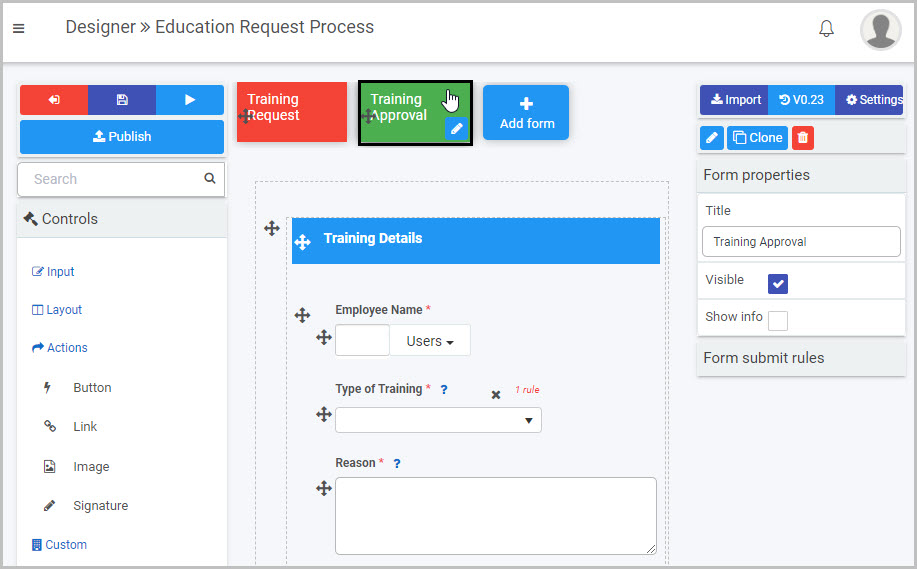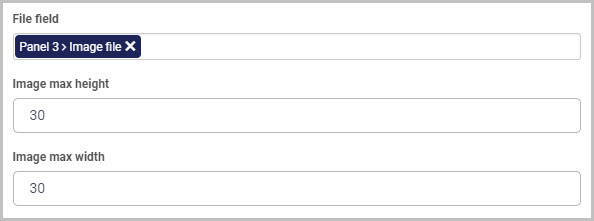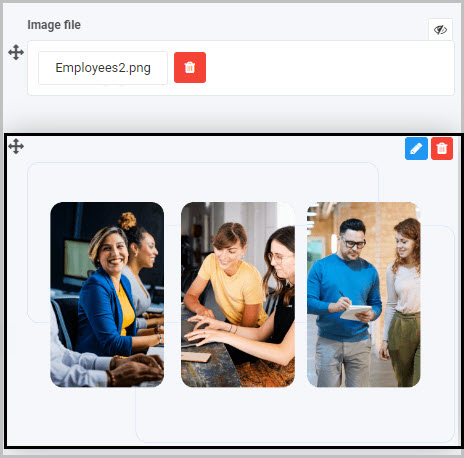Image fields can be used to insert and display images, either statically or images captured from File upload fields. For example, you may wish to insert an image at the top of your form or may wish to enable form users to annotate an image.
How to get started
To add an Image field to a Kianda form:
-
Open an existing process by going to Administration > Designer in the left side menu and clicking on a process, or create a new process in Designer. See Create First Process to learn how to create your first process.

-
Once you have opened your process, select the form you want to work on (so that the Edit Form button
 is shown).
is shown).In this example, a Training Approval form in an Education Request Process has been selected:

-
Select the area within the form where you want to insert the Image field - in our example, we will select the first panel in the form - Training Details:

-
Click on Controls in the left-hand pane, and, from the four categories of Controls (Input, Layout, Actions and Custom), click on Actions.
-
Select Image from the four types of Action fields: Button, Link, Image and Signature:

-
A New field - Image dialog box will automatically open, giving you options for your new Image field:

-
Title - You can change the name of the Image field from the default ‘Image 1’. In our example, we could change the title to ‘Employees’.
-
Name (Unique) - This is a unique name for the new field and inherits a camel case version of the entered Title.
-
Help text - You can insert text to help the form user. If you add help text, a question mark
 icon will appear next to the field title and, if the user clicks on this, they will see the help text you have inserted.
icon will appear next to the field title and, if the user clicks on this, they will see the help text you have inserted. -
Custom CSS class name - You can type the name of a CSS class to allow the Image to inherit specific styles defined in the Global CSS file.
-
Image source - You can choose to insert the image either from an Image URL or from a File field within the form. Different additional options will be available to you, dependent on the Image source you choose.
(i) If you choose Image URL as the Image source, insert the URL for the image into the Image URL field:

Then complete the Image max height and Image max width options:
-
Image max height - Insert the maximum height (in pixels) for your new Image field by either manually inserting a number or using the up down arrows
 to the right of the field.
to the right of the field. -
Image max width - Insert the maximum width (in pixels) for your new Image field by either manually inserting a number or using the up down arrows
 to the right of the field.
to the right of the field.
When you’ve completed the New field - Image dialog box and clicked OK, your new Image field will be inserted at the bottom of the area you selected - in our case, at the bottom of the first panel in the Training Approval form:

(ii) If you choose File field as the Image source, three additional options will be displayed below the ‘Image max height’ and ‘Image max width’ options - Enable image annotations, Display images inline and Enable quick remove image:

To use a File field as the Image source, you must first have inserted a File Upload field into your form and it must hold an image file.
In our example, you could insert a File Upload field titled ‘Image file’ into the panel where you want to insert the new Image field and then browse to find an image you have saved on your computer:

You could choose to make this File Upload field invisible to form users, by ensuring the Visible checkbox is not selected in the Field Properties menu to the right.
If you want to allow form users to make annotations on the Image, make sure to select Yes to the Allow file override option in the New field - File dialog box. To learn more about File Upload fields, see File Upload field.
Once the File Upload field has been added to the form and it contains the image file you want to use, you can then insert an Image field and, in the dialog box, choose File field as your Image source, click into the File field and select the field containing the image:

Then complete the Image max height and Image max width fields:

In our example, if we inserted an Image field using a File field as the Image source (and choose not to make the File field visible to form users), the new Image field could look like this once inserted in our form:

You have three additional options if you choose File field as your Image source:
-
Enable image annotations - If you choose Yes, this will enable both you (as the Form Designer) and the end user (the form user) to make annotations to the Image - such as adding a text comment or inserting a shape.
To make annotations to the Image as the Form Designer, choose Yes to ‘Enable image annotations’ and after clicking OK at the bottom of the New field - Image dialog box, click on the new Image field that has been added to your form:

When you click on the Image, a new pop-up box will open, with an Annotate Image button at the top right:

Click on this Annotate Image button and a menu will display with a range of options for annotating the image:

The options available for annotating the image include:
- Undo the last annotation

- Draw a rectangle

- Draw a circle

- Write some text

- Draw an arrow

- Pen tool
 (which allows you to do a free hand drawing on the image)
(which allows you to do a free hand drawing on the image) - Redo the last undone annotation

An end user completing the form will be able to make annotations to the image in the same way - by clicking on the Image in the form and then clicking the Annotate Image button to view the menu.
When you have made the changes you want to the image, click on the green Save button
 . This annotation will then be visible in the image in your form.
. This annotation will then be visible in the image in your form.If you choose Yes to Enable image annotations, another option is shown - Keep original image:

If you choose Yes for Keep original image, when the Image field is annotated, both the original image and annotated image will be shown side by side and will both be saved in the location you chose as the ‘Destination’ in the File Upload field.
-
Display images inline - Select Yes if you want the Image field to appear in line with the text in your form.
-
Enable quick remove image - If you select Yes, a Bin/Trash button
 will be available to the form user at the bottom of the Image field in the form, enabling them to delete the image by clicking on it.
will be available to the form user at the bottom of the Image field in the form, enabling them to delete the image by clicking on it.
-
-
When you have finished selecting the options you want for your new Image field in the New field - Image dialog box, click OK and the Image will be added to your form.
-
You can preview how the image will look to an end user by first saving the changes you’ve made to your form (by clicking on the Save button
 ) and then clicking the Preview
) and then clicking the Preview  button.
button.In our example, if we added an Image field to our Training Approval form and choose a File field as the Image source and to allow the user to make annotations to the image - it could look like this to user completing the form on their mobile phone:

If you chose to enable image annotations, the form user can click on the image, click on the Annotate image button
 and then use the options in the menu to make annotations on the image and save these.
and then use the options in the menu to make annotations on the image and save these.
How to edit, move and delete Image fields
To edit an Image field:
-
Select the Image field (by either clicking on the field name or on the field’s drag handle button
 ).
). -
Click on the Edit Field button (Pen icon)
 .
.
-
The Edit Field - Image dialog box will open (with the Image field title you chose reflected in the dialog box name), enabling you to choose from the same range of options as appear in the New field - Image dialog box (as already discussed in How to get started).

To move an Image field, simply:
-
Select the Image field’s drag handle button
 .
. -
Drag and drop the Image field wherever you want to move it within your form.
For example, when we added the ‘Employees’ Image field to the first panel in the Training Approval form, it was automatically inserted at the bottom of the panel - if we want it to show at the top of the panel, we can simply drag the image to the top of the panel and drop it there:

To delete an Image field from your form:
- Select the Image field (by either clicking on the field’s title or drag handle button
 ).
). - Click on the Bin/Trash button
 .
. - Click on OK to confirm.
How to view and edit Image control Field properties
To view or edit an Image control’s Field properties:
-
Select the Image field (by either clicking on the field title or on its drag handle button
 ).
). -
The Field Properties associated with the Image field will be displayed (and can be changed) in the Field properties menu to the right.

For example, the Field Properties associated with an Image field titled ‘Employees’ are shown here and include:
-
Field type - The type of field, in this case an Image field.
-
Title - The Title of the field, in this case ‘Employees’.
-
Show title - If this is selected, the Image field title will be shown in the form.
-
Required - If this is selected, the field will be mandatory for the form user.
-
Enabled - If this is selected, the user will be able to edit or interact with the field.
-
Visible - If this is selected, the Image field will be visible in the form.
-
Layout - The width of the blue bar can be adjusted to change the width of the Image field as it appears on a PC or mobile phone (to view the Mobile layout, click on the expand button
 to the right).
to the right).For more details, go to Field Properties.
-
Saving changes and version history
Make sure to save any changes you make by clicking on the Save button  . You will always have the option to revert back to previous versions of your form by clicking the Design Version History
. You will always have the option to revert back to previous versions of your form by clicking the Design Version History  button in the top right corner.
button in the top right corner.
What’s next 
Now that you’ve learned about Image controls, find out more about the other types of Action fields you can add to Kianda forms: